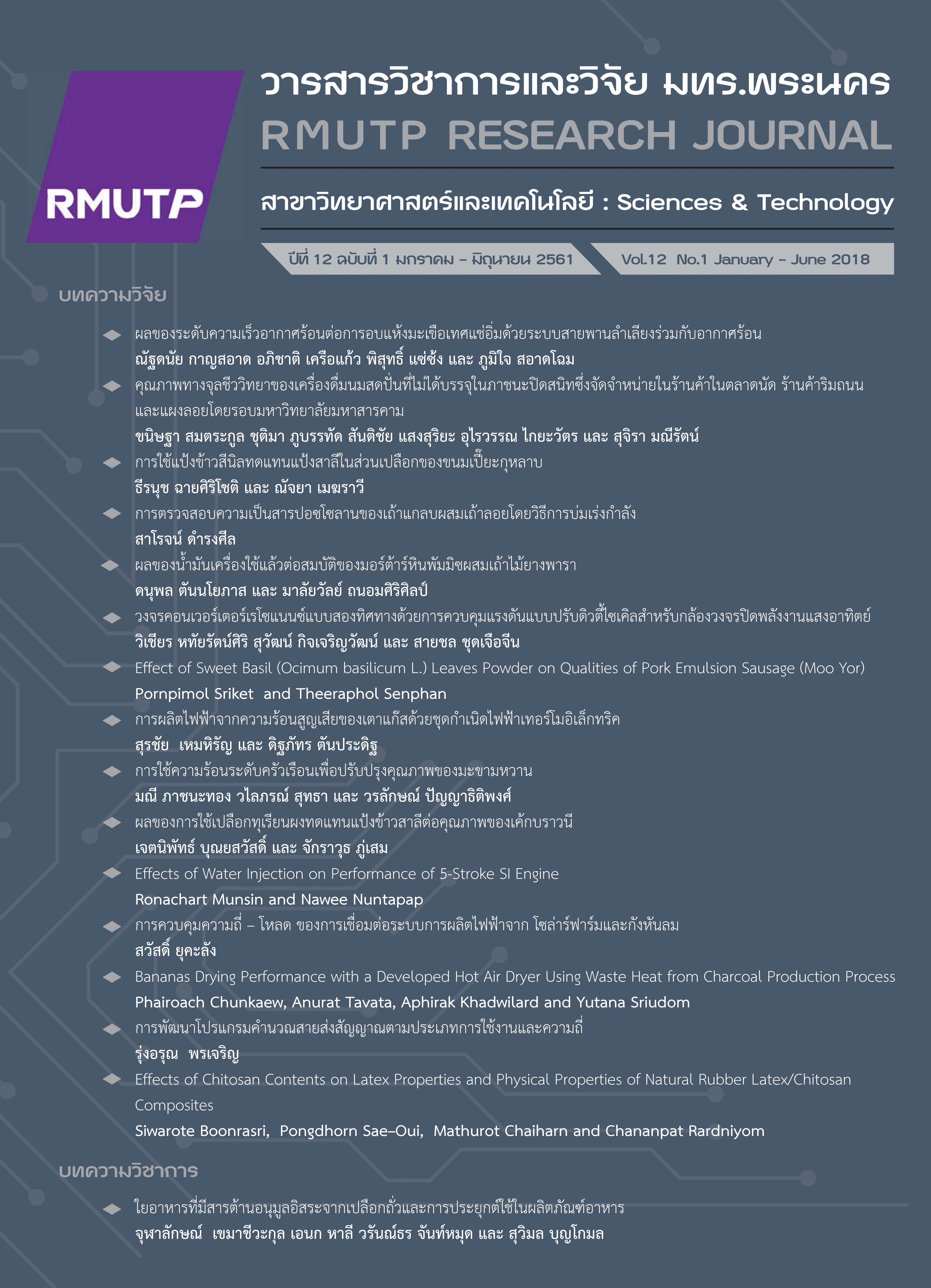Household Heat Use to Improve Sweet Tamarind Quality
Main Article Content
Abstract
Sweet tamarind is a unique and economic plant of Phetchaboon province and it has already been geographical indication (GI) registered. One of its main problems is fungal degeneration which cannot be physically visible. This causes the consumer’s uncertainty on its quality, especially sweet tamarind from small communities. This led to the study on the use of household heat to reduce fungal degeneration by steaming at 100°C for 50, 60, 70 and 80 minutes and drying in the hot air oven at 70°C for 3 hours. It was found that increasing the heat resulted in darkening the sweet tamarind color and heightening up its moisture content (p<0.05). Drying temperature at 60, 70 and 80°C revealed the higher the heat, the shorter the drying time and the sweet tamarind content was darker. In addition, drying significantly decreased the moisture and preference score of sweet tamarind (p<0.05). The storage of sweet tamarind in mesh bag at ambient temperature revealed that the increase of the storage time resulted in a significant increase in the moisture of the sweet tamarind shell (p<0.05) and could preserve the tamarind for at least 12 weeks without the deterioration from the fungus.
Article Details

This work is licensed under a Creative Commons Attribution-NonCommercial-NoDerivatives 4.0 International License.
ลิขสิทธ์ ของมหาวิทยาลัยเทคโนโลยีราชมงคลพระนครReferences
B. Jarimopas, D. Rachanukroa, S.P. Singh, R. Sothornvit, “Post-harvest damage and performance comparison of sweet tamarind packaging,” Journal of Food Engineering, vol. 88 pp. 193-201, 2008.
Department of Agriculture, Postharvest Diseases of fruit, 1st ed. Bangkok: Chamchuri Product, 2014.
C. Sartpetch, A. Suwanagul, M. Lanchai, T. Boonlkang and J. Pankhwan, “Effect of Sulfur dioxide on postharvest qualities of sweet tamarind cv. Si thong,” in Proceeding of 53rd Kasetsart University Annual Conference, Thailand, 2015, pp. 454-458.
C. Oupadissakoon, E. Chambers IV, V. Kongpensook, S. Suwonsichon, R. Yenket and A. Retiveau, “Sensory properties and consumer acceptance of sweet tamarind varieties grown in Thailand,” Journal of The Science of Food and Agriculture, vol. 90, pp. 1081-1088, 2010.
L. Ruck and C.T. Brown, “Quantitative analysis of Munsell color data from archeological ceramics,” Journal of Archaeological Science: Reports, vol. 3, pp. 549-557, 2015.
N. Van den Bilcke, K. Alaerts, S. Ghaffaripour, D.J. Simbo and R. Samson, “Physico-chemical properties of tamarind (Tamarindus indica L.) fruits from Mali: selection of elite trees for domestication,” Genetic Resources and Crop Evolution, vol 61, pp. 537-553, 2014.
M. Riederer, K. Arand, M. Burghardt, H. Huang, M. Riedel, A. Schuster, A. Smirnova and Y. Jiang, “Water loss from litchi (Litchi chinensis) and longan (Dimocarpus longan) fruits is biphasic and controlled by a complex pericarpal transpiration barrier,” Planta, vol. 242, pp. 1207-1219, 2015.
S. Suktanarak and S. Teerachaichayut, “Detection for moisture content of sweet tamarind flesh by transmittance short wavelength near infrared spectroscopy,” in International Proceeding of Chemical, Biological and Environment, International Conference on Nutrition and Food Sciences, Singapore, 2012 pp. 71-75.
S. Luengthanaphol, D. Mongkholkhajornsilp, S. Douglas, P.L. Douglas, L. Pengsopa and S. Pongamphai, “Extraction of antioxidants from sweet Thai tamarind seed coatpreliminary experiments,” Journal of Food Engineering, vol 63, pp. 247-252, 2004.
M. Miranda, A. Vega-Galvez, P. Garcia, K.D. Scala, J. Shi, S. Xue and E. Uribe, “Effect of temperature on structural properties of Aloe vera (Aloe barbadensis Miller) gel and Weibull distribution for modelling drying process,” Food and Bioproducts Processing, vol. 88, pp. 138-144, 2010.
I. Karabulut, A. Topcu, A. Duran, S. Turan and B. Ozturk, “Effect of hot air drying and sun drying on color values and β-carotene content of apricot (Prunus armenica L.),” LWT-Food Science and Technology, vol. 40 pp. 753-758, 2007.
H. Sabarez, W.E. Price, P.J. Back and L.A. Woolf, “Modelling the kinetics of drying of d’ Agen plums (Pruns demestica),” Food Chemistry, vol. 66, no. 3, pp. 371-382, 1997.
A. Wojdylo, A. Figiel and J. Oszmianski, “Effect of drying methods with the application of vacuum microwaves on the bioactive compounds color, and antioxidant activity of strawberry fruits,” Journal of Agricultural and Food Chemistry, vol. 57, pp. 1337-1343, 2009.
F.A. Mohos, Confectionery and Chocolate Engineering: Principles and Applications, 1st ed. Singapore: Wiley-Blackwell, 2010.
J.M. deMan, Principles of Food Chemistry, 3rd ed. Maryland: Aspen, 1999.
J. Ryckeboer, J. Mergaert, K. Vaes, S. Klammer, D.D. Clercq, J. Coosemans, H. Insam and J. Swings, “A survey of bacteria and fungi occurring during composting and self-heating processes,” Annals of Microbiology, vol. 53, no. 4, pp. 349-410, 2003.
D. Udayanga, X. Liu, E.H.C. McKenzie, E. Chukeatirote, A.H.A. Bahkali and K.D. Hyde, “The genus Phomopsis: biology, applications, species concepts and names of common phytopathogens,” Fungal Diversity, vol 50, pp.189-225, 2011.
L.M. Coated, A.W. Cooke and J.R. Dean, “The response of mango stem end rot pathogens to heat”, in Proceeding of V International Mango Symposium (ISHS), Acta Horticulturae, 1997, pp. 762-772.

